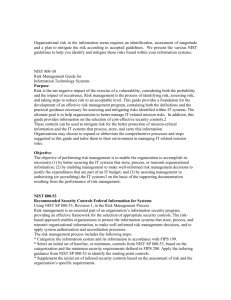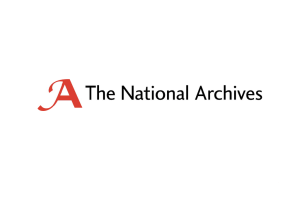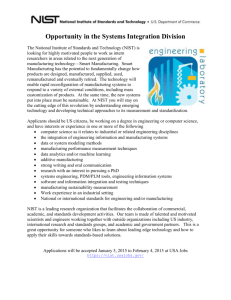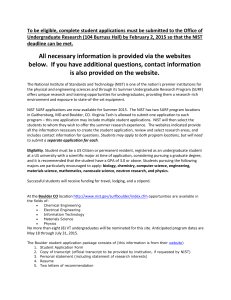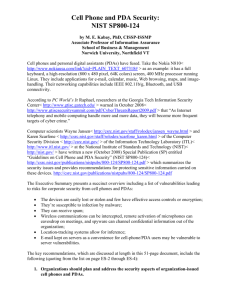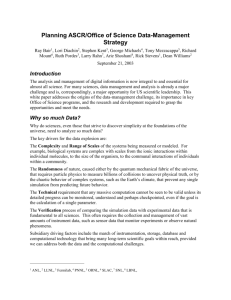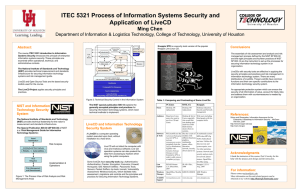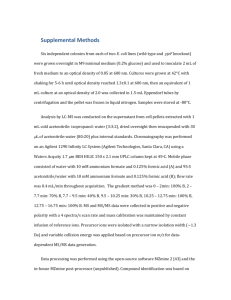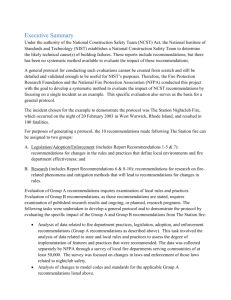Current NIST Definition
advertisement
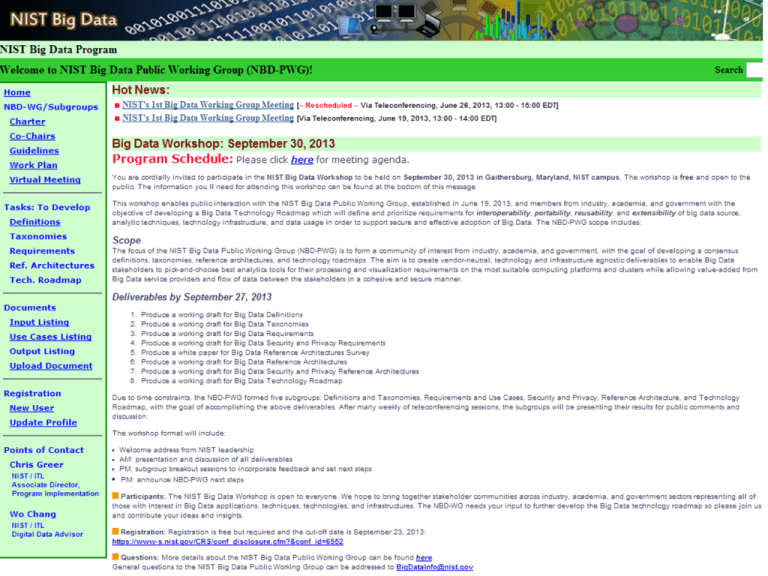
Current NIST Definition • NIST Big data consists of advanced techniques that harness independent resources for building scalable data systems when the characteristics of the datasets require new architectures for efficient storage, manipulation, and analysis. • Big data is where the data volume, acquisition velocity, or data representation limits the ability to perform effective analysis using traditional relational approaches or requires the use of significant horizontal scaling (more nodes) for efficient processing Slightly faster than Moore’s law Zettabyte = 1 million Petabytes IP Traffic ~ 1 Zettabyte per year in 2015 Meeker/Wu May 29 2013 Internet Trends D11 Conference 3 Why need cost effective Computing! Full Personal Genomics: 3 petabytes per day Faster than Moore’s Law Slower? https://portal.futuregrid.org http://www.genome.gov/sequencingcosts/ 4 • • • • • • • • Some Data sizes ~40 109 Web pages at ~300 kilobytes each = ~10 Petabytes Earth and Polar Observation several petabytes per year Large Hadron Collider 15 PBs/ year (300K cores 24 by 7) Radiology 69 PBs per year • imagery common source of big data from medical/scientific instruments; surveillance devices; Facebook uploading 500M a day; synchrotron light sources Square Kilometer Array Telescope will be 100 terabits/second (~400 exabytes/year); currently astronomy has ~100TB in a large collection; petabytes total Internet of Things: 25-50 Billion devices on Internet 2020 Exascale simulation data dumps – terabytes/second Deep Learning to train self driving car; 100 million megapixel images ~ 100 terabytes https://portal.futuregrid.org 5 NIST Big data Taxonomy Philosophy • “Big Data” and “Data Science” are currently composites of many concepts. To better identify those terms, we first addressed the individual concepts needed in this disruptive field. Then we came back to clarify the two over-arching buzzwords to provide clarity on what concepts they encompass. • To keep the topic of data and data systems manageable, we tried to restrict our discussions to what is different now that we have “big data”. • 30 documents studying issue! Current NIST Definitions • Data Science is extraction of actionable knowledge directly from data through a process of discovery, hypothesis, and analytical hypothesis analysis. • A Data Scientist is a practitioner who has sufficient knowledge of the overlapping regimes of expertise in domain knowledge, analytical skills and programming expertise to manage the end-to-end scientific method process through each stage in the big data lifecycle. McKinsey Institute on Big Data Jobs • There will be a shortage of talent necessary for organizations to take advantage of big data. By 2018, the United States alone could face a shortage of 140,000 to 190,000 people with deep analytical skills as well as 1.5 million managers and analysts with the know-how to use the analysis of big data to make effective decisions. http://www.mckinsey.com/mgi/publications/big_data/index.asp. 8 The 4 paradigms of Scientific Research 1. Theory 2. Experiment or Observation • E.g. Newton observed apples falling to derive his equations 3. Simulation of theory or model (Computational Science) 4. The Fourth Paradigm: Data-driven or Data-Intensive Scientific Discovery (Data Science) • • • • http://research.microsoft.com/enus/collaboration/fourthparadigm/ A free book Data (not theory) drives discovery process Clear for recommender systems. There are no “Newton’s equations” of user rankings of movies or books but ranking data identifies who is like you and so suggests what you might like Jobs in data science (category 4) much larger than computational science (category 3) DIKW Pipeline • (raw) Data Information Knowledge Wisdom, Decisions, Policy, Benefit …. • Big data refers to all stages of pipeline e.g. it includes “Big Benefit” • Analytics at each stage but especially at Information Knowledge transformation • Information as a Service (cloud hosted NOSQL or SQL repository) transformed by Software as a Service (Image Processing, Collaborative Filtering ….) gives Knowledge as a Service Use Case Template • 26 fields completed for 51 areas • Government Operation: 4 • Commercial: 8 • Defense: 3 • Healthcare and Life Sciences: 10 • Deep Learning and Social Media: 6 • The Ecosystem for Research: 4 • Astronomy and Physics: 5 • Earth, Environmental and Polar Science: 10 • Energy: 1 51 Detailed Use Cases: Many TB’s to many PB’s • Record analysis requirements, data volume, velocity, variety, software and analytics etc. • Government Operation: National Archives and Records Administration, Census Bureau • Commercial: Finance in Cloud, Cloud Backup, Mendeley (Citations), Netflix, Web Search, Digital Materials, Cargo shipping (as in UPS) • Defense: Sensors, Image surveillance, Situation Assessment • Healthcare and Life Sciences: Medical records, Graph and Probabilistic analysis, Pathology, Bioimaging, Genomics, Epidemiology, People Activity models, Biodiversity • Deep Learning and Social Media: Driving Car, Geolocate images, Twitter, Crowd Sourcing, Network Science, NIST benchmark datasets • The Ecosystem for Research: Metadata, Collaboration, Language Translation, Light source experiments • Astronomy and Physics: Sky Surveys compared to simulation, Large Hadron Collider at CERN, Belle Accelerator II in Japan • Earth, Environmental and Polar Science: Radar Scattering in Atmosphere, Earthquake, Ocean, Earth Observation, Ice sheet Radar scattering, Earth radar mapping, Climate simulation datasets, Atmospheric turbulence identification, Subsurface Biogeochemistry (microbes to watersheds), AmeriFlux and FLUXNET gas sensors • Energy: Smart grid
